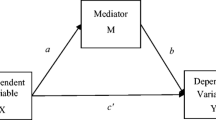Abstract
Each cognitive behavior therapy has produced research concerning the cognitive construct it posits to mediate psychopathology. This study attempted to compare the major cognitive behavioral constructs to determine how they are related to each other and how each is related to teachers' perception of externalized and internalized behavioral and emotional problems. Children between the ages of 9 to 13 were classified as internalized, externalized, mixed, or no behavior and emotional problems groups according to their scores on the Teacher's Report Form of the Child Behavior Checklist and teachers' ratings on the Walker Problem Identification Scale. Measures of Ellis' (1962) irrationality, Beek's (1976) negative automatic thoughts, Spivack's (Spivack, Platt, & Shure, 1976) social problem skills, and Meichenbaum's (1977) guiding self statements were administered to the children. The results indicated that the various cognitive constructs were only moderately correlated with each other. Irrational beliefs and cognitive distortions were correlated higher than other comparisons. The correlations between the measures of the constructs suggest they are slightly related but represent different constructs. The emotional and behavioral problems groups scored higher than the no problems group on some subtest of irrational beliefs and negative cognitive thoughts. Also, the measures of emotional and behavior problems correlated significantly with some subtest of irrational beliefs and negative automatic thoughts. Irrational beliefs appeared to be related to internalized and externalized emotional and behavioral problems, while negative automatic thoughts appeared to be best related to internalized emotional and behavioral problems. The measures of problem solving skills and guiding self statements appear to be best related to externalized problems.
Similar content being viewed by others
REFERENCES
Achenbach, T. M., & Edelbrock, C. S. (1983). Manual for the Child Behavior Checklist and the Revised Child Behavior Profile. Burlington, VT: University Associates in Psychiatry.
Anastopoulos, A. D., Shelton, T. L., Pottebaum, S., & Broek, L. (1987). A Self-Report Rating Scale for Children Lacking Self-Control. Paper presented at American Psychological Association, New York.
Beck, A. (1976). Cognitive therapy and the emotional disorders. New York: International Universities Press.
Beck, A. T., Rush, A. J., Shaw, B., & Emery, G. (1979). Cognitive therapy of depression. New York: The Guilford Press.
Bernard, M. E., & Cronam, F. (1999). The Child and Adolescent Scale of Irrationality: Validation data and mental health correlates. Journal of Cognitive Psychotherapy: and International Quarterly, 13(2), 121–132.
Bernard, M. E., & DiGiuseppe, R. (1990). Guest editors' comments: Rational emotive therapy and school psychology. School Psychology Review, 19(3),267.
Connolly, J. (1987, Nov.). Adolescent Social Problem-Solving Measure. Poster Session Presented at the Association for Advancement of Behavior Therapy Annual Convention, New York.
DiGiuseppe, R., Sutton-Simon, K., McGowen, & Gardener, F. (1991). Comparison of cognitive and behavioral approaches treating social anxiety. Journal of Rational-Emotive and Cognitive-Behavior Therapies, 8(3), 129–146.
Dodge, K. (1985). Facets of social interactions and the assessment of social competence in children. In B. Schneider, K. Rubin, & J. Ledingham (Eds.), Children's Peer Relationships: Issues in Assessment and Intervention (pp. 3–27) New York: Springer-Verlag.
Ellis, A. (1962). Reason and emotion in psychotherapy. Secaucus, NJ: Lyle Stuart.
Ellis, A. (1987). A sadly neglected fact about depression. Cognitve Therapy and Research, 11, 121–146.
Feindler, E. (1991). Cognitive strategies for anger control interventions for children and adolescents. In P. Kendall (Ed.), Child and Adolescent Therapy: Cognitive-behavioral procedure (pp. 66–97). New York: The Guilford Press.
Hughes, J., (1988). Cognitive Behavior Therapy with Children in Schools. New York: Pergamon.
Hughes, J., and Hall, R. (1989). Cognitive Behavioral Psychology in the Schools: A Comprehensive Handbook. New York: Guilford.
Kendall, P. (1991a). Guiding theory for therapy with children and adolescents. In P. Kendall (Ed.), Child and Adolescent Therapy: Cognitive-behavioral procedure (pp. 3–24). New York: The Guilford Press.
Kendall, P. (1991b). Treating anxiety disorders in children and adolescents. In P. Kendall (Ed.), Child and Adolescent Therapy: Cognitive-behavioral procedure (pp. 131–164). New York: The Guilford Press.
Kendall, P. (Ed.) (1991c). Child and Adolescent Therapy: Cognitive-behavioral procedure. New York: The Guilford Press.
Kovacs, M., & Beek, A. (1977). An empirical-clinical approach toward a definition of childhood depression. In J. G. Schulterbrandt and A. Raskin (Eds.), Depression in childhood: Diagnosis, treatment, and conceptual models (pp. 1–25). New York: Raven Press.
Leitenberg, H., Yost, L., & Carroll-Wilson, M. (1986). Negative cognitive errors in children: Questionnaire development, normative data, and comparisons between children with and without self-reported symptoms of depression, low self-esteem, and evaluation anxiety. Journal of Consulting and Clinical Psychology, 54, 528–536.
Meichenbaum, D. (1977). Cognitive-behavior modification: An integrative approach. New York: Plenum Press.
Platt, J., Spivack, G., Altman, N., Altman, D., & Peizer, S. B. (1974). Adolescent problem-solving thinking. Journal of Consulting and Clinical Psychology, 42, 787–793.
Spivack, G., Platt, J., & Shure, M. (1976). The problem-solving approach to adjustment. San Francisco: Jossey-Bass.
Stark, K. D., Rouse, L. W., & Livingston, R. (1991). Treatment of depression during childhood and adolescence: Cognitive behavioral procedures for the individual and family. In P. Kendall (Ed.), Child and Adolescent Therapy: Cognitive-behavioral procedure (pp. 165–208). New York: The Guilford Press.
Walker, H. M. (1983). Walker problem behavior identification checklist. Los Angeles: Western Psychological Services.
Warrens, R., & Zgourides, G. (1991). Anxiety disorders: A rational emotive perspective. New York: Pergamon.
Author information
Authors and Affiliations
Rights and permissions
About this article
Cite this article
Silverman, S., DiGiuseppe, R. Cognitive-Behavioral Constructs and Children's Behavioral and Emotional Problems. Journal of Rational-Emotive & Cognitive-Behavior Therapy 19, 119–134 (2001). https://doi.org/10.1023/A:1011183506003
Issue Date:
DOI: https://doi.org/10.1023/A:1011183506003




